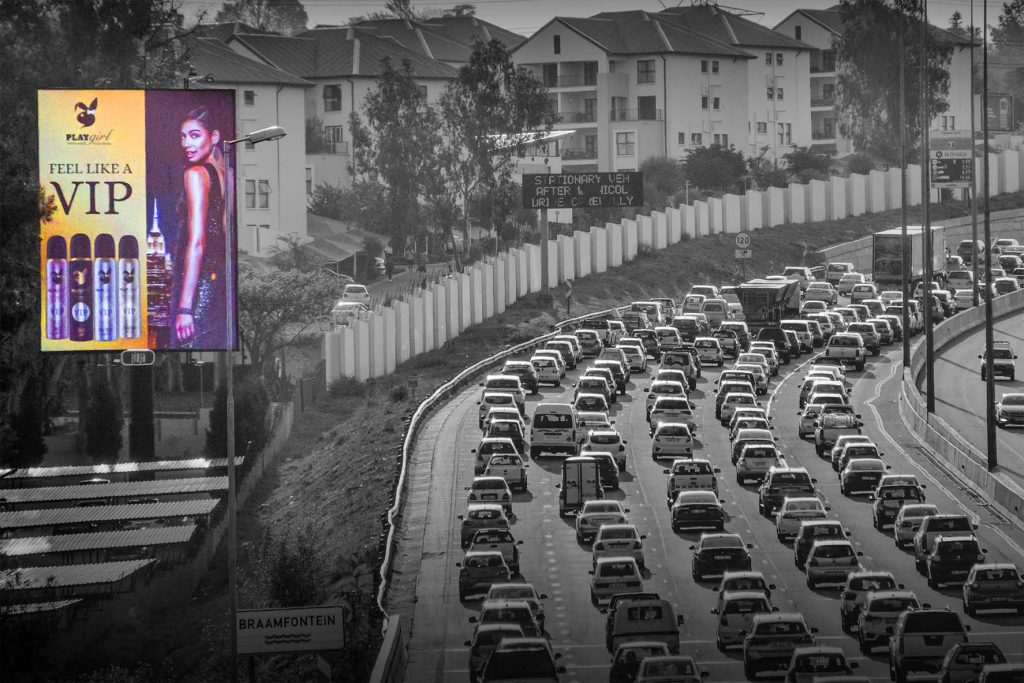Traditional Billboard Media

Billboards provide advertisers with high impact, high frequency exposure to large volumes of commuters. Traditional billboards offer advertisers a choice of a broad range of sizes, formats, and costs to meet the specific media needs of your campaign. A great advantage of traditional billboards is their ubiquity across the South African roadside landscape and, as such, advertisers can directly target their audience based on their geographic location and frequent travel routes. From highways to arterials, suburban roads to convergence nodes, shopping malls to taxi ranks, billboards have your target audience covered.
Mega Format Media

Bold and imposing, mega billboards command the attention of commuters on South African roads. Characterised by their massive facades and large structures, mega format media—such as container billboards and towers—offer advertisers a compelling solution for attaining “big brand feel”. Mega format media is frequently positioned on landmark sites (e.g. large building wraps) and often these iconic billboards become landmarks themselves.
Digital Out-of-Home

DOOH (digital out-of-home) enables advertisers to integrate digital elements into their outdoor campaigns resulting in an advertising medium that is both highly impactful and highly flexible. Apart from the very visible benefits of bright, vibrant, and engaging creative, DOOH is also a cost-effective medium for advertisers who want the flexibility of changing creative in real-time, as often as desired, without any associated printing or flighting costs. DOOH has great synergy with other types of media and is an effective component of any omnichannel marketing campaign. It shares some of the benefits of other media channels—for example, real-time digital campaign monitoring—but it also has its own unique advantages such as immunity to ad blockers and no option for audiences to skip your ad. Demand for DOOH media has accelerated in recent years and supply has followed suit. As such, advertisers have access to a broad audience across various locations and LSM/SEM segments via DOOH.
Airport Media

With over 15 million domestic passenger trips and 2.8 million international passengers post-Covid in 2021, South African airports remain busy convergence nodes for high LSM/SEM individuals and are a compelling option for advertisers to reach this high-income segment of their audience. Aiport media can be found on both the landside and airside terminals, as well as alongside the airport roads and in parking lots. Airport media comprises both static and digital platforms, ensuring a wide variety of choices for advertisers to reach the right people at the right location.
Transit Media

According to StatsSA, at least 14 million South Africans make use of public transportation each week. Transit media targets these commuters with advertising on the vehicles themselves—i.e. bus branding, taxi branding, and train branding—as well as the infrastructure that supports them e.g. taxi ranks, bus stations, and train stations. Not only is transit media a perfect fit for reaching audiences within the mass market, but certain types of transit media—such as bus branding—target audiences within their own vehicles in the same way that a moving billboard would.
Street Pole Ads & Street Furniture

Street Pole Ads (SPAs) and other street furniture media take the top spot for affordability. Bus shelters, street finders, suburb signs, pave ads, and SPAs are all effective media for engaging with both commuters and pedestrians. Typically located alongside highly congested roads, SPAs and street furniture ensure high dwell time for both commuters and pedestrians and make for perfect directional signage. SPAs are also a great medium for telling a short story with posters in sequence.